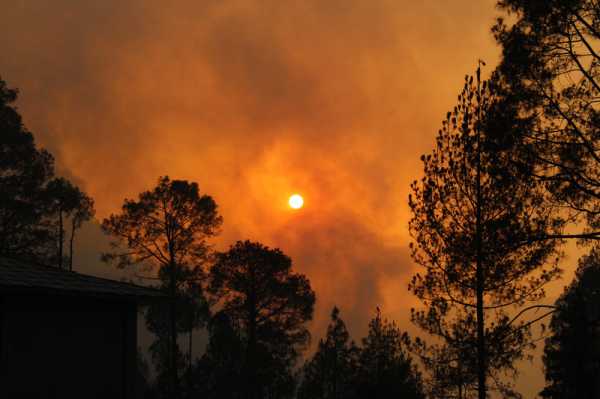
The science is clear: burning wood to produce energy makes climate change worse for decades or more, time we do not have to avoid the worst harms from climate change (Photo: Sukhdev Singh)
On Wednesday (29 March), EU co-legislators are hoping to finalise the re-cast Renewable Energy Directive. They have a chance to correct a historic mistake on wood burning.
The science is clear: burning wood to produce energy makes climate change worse for decades or more, time we do not have to avoid the worst harms from climate change. Yet the EU and UK continue to declare that forest biomass is, in effect, zero carbon, allowing these nations to subsidize wood bioenergy and omit the carbon dioxide (CO2) from burning that wood from their emissions accounts.
Subsidies in Europe for burning ‘woody biomass’ now exceed €10bn per year, causing significant growth in bioenergy, which now comprises some 60 percent of the EU’s renewables.
But burning wood for energy increases CO2 emissions even if the wood displaces coal. The EU and the bioenergy industry claim that the trees cut for energy will regrow, eventually removing the extra CO2 from the atmosphere. But regrowth is not certain, and regrowth takes time—many decades or longer. In the meantime, burning wood makes climate change worse.
The result? The citizens of the EU and UK are paying for their governments to claim that they are reducing emissions while actually making climate change worse.
Much of the debate over wood energy centres on whether the major industry players — be they pellet mills or power plants — have been sourcing primarily stemwood or forest and sawmill residues.
Abundant photographic evidence shows many in fact rely to a large extent on stemwood. Eliminating primary woody biomass from subsidy (as recommended by the European parliament) could help avoid some of its most perverse climate effects as well as reducing soil erosion and habitat loss. However, even burning thinnings and forest residues puts more CO2 into the air per kWh generated than fossil fuels.
That means that the first impact of wood bioenergy, whether from whole trees or residues, is an increase in atmospheric CO2, accelerating climate change, even if the wood displaces coal–a critical step backwards that will not be reversed for decades or longer—time we do not have to meet the Paris commitments and avoid the worst harms from climate change.
The science has repeatedly been shared with EU policymakers. In January 2018, when the EU was first reassessing the renewable energy directive, 772 scientists wrote a letter to MEPs making these points.
A critical commentary in Nature Communications concluded that: “Overall, replacing fossil fuels with wood will likely result in 2-3x more carbon in the atmosphere in 2050 per gigajoule of final energy.”
In September 2019, the European Academies Science Advisory Council (EASAC), which includes all the national science academies of EU countries whose environment programme is headed by one of the present authors, published a paper arguing that “serious mismatches continue between science and policy in forest bioenergy”.
This was on top of a 2018 commentary on “Forest Bioenergy and Carbon Neutrality”. Ahead of the COP25 meeting in Madrid in December 2019, EASAC scientists issued a further statement to policymakers: “We have repeatedly pointed out that in many cases the large-scale substitution of coal by forest biomass will accelerate climate warming.”
Sign up for EUobserver’s daily newsletter
All the stories we publish, sent at 7.30 AM.
By signing up, you agree to our Terms of Use and Privacy Policy.
Since 2018, there have been three further letters from hundreds of scientists (including a former vice chair of the IPCC) pointing out the dangers of wood bioenergy to the climate and to biodiversity — and the European Commission’s own Joint Research Centre — in a mammoth review of the literature in 2021 — concluded that only the burning of small twigs and branches would be better for the climate over a ten year period than continuing to burn fossil fuels. All other feedstocks taken from forests are much worse.
The urgency of ceasing all subsidies for forest biomass, whatever its source, is underlined again and again by the IPCC in its urgent call to reduce emissions fast and now. Biomass merely offers the possibility of reducing emissions overall, at some time in the future, by which time 1.5 or 2 degree targets will have been overshot, locking humanity into irreversible and dangerous climate change.
The European Parliament’s modest first step towards weaning us from this harmful practice of excluding ‘primary woody biomass’ from subsidy, will feature this week in the final negotiation between MEPs, the Commission and member state governments on the Renewable Energy Directive.
But even this small step is under severe attack by industries and countries who have become dependent on subsidies for bioenergy.
Should they prevail, EU countries will continue to spend their renewable energy subsidies on a technology that adds CO2 to the atmosphere and accelerates global warming and the damage it causes: faster melting of Greenland and Antarctica, higher sea level rise, worse droughts, extreme weather, crop yield decline, deaths from heat waves, and other harms from climate change that will not be reversed even if the forests eventually regrow.
As the IPCC said last week, we need meaningful action now. Adopting the parliament’s case to remove primary woody energy from the EU’s Renewable Energy Directive would be a good start.
You can read the Land and Climate Review briefing on the science of biomass burning — as well as details of the several on-the-ground investigations there have been into wood harvesting for energy in Europe.
Source: euobserver.com